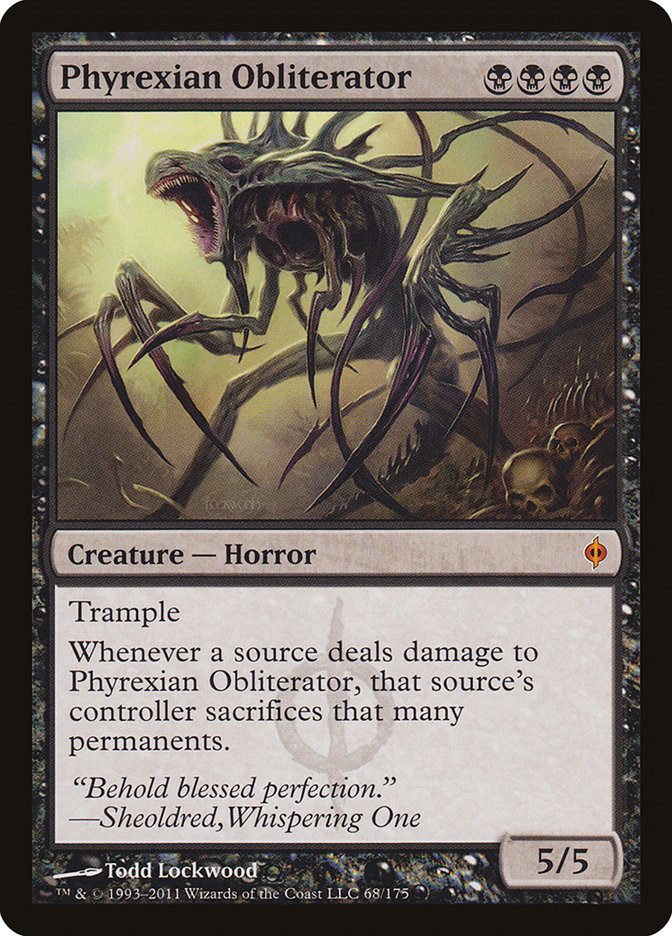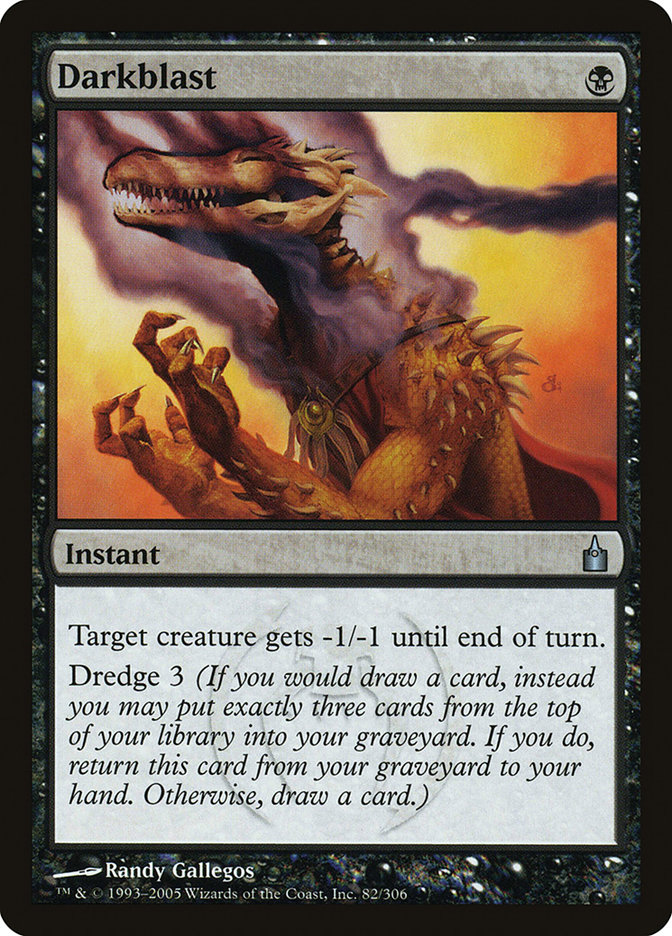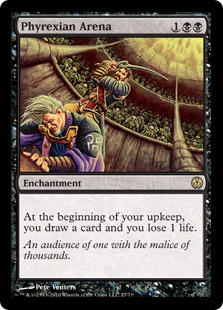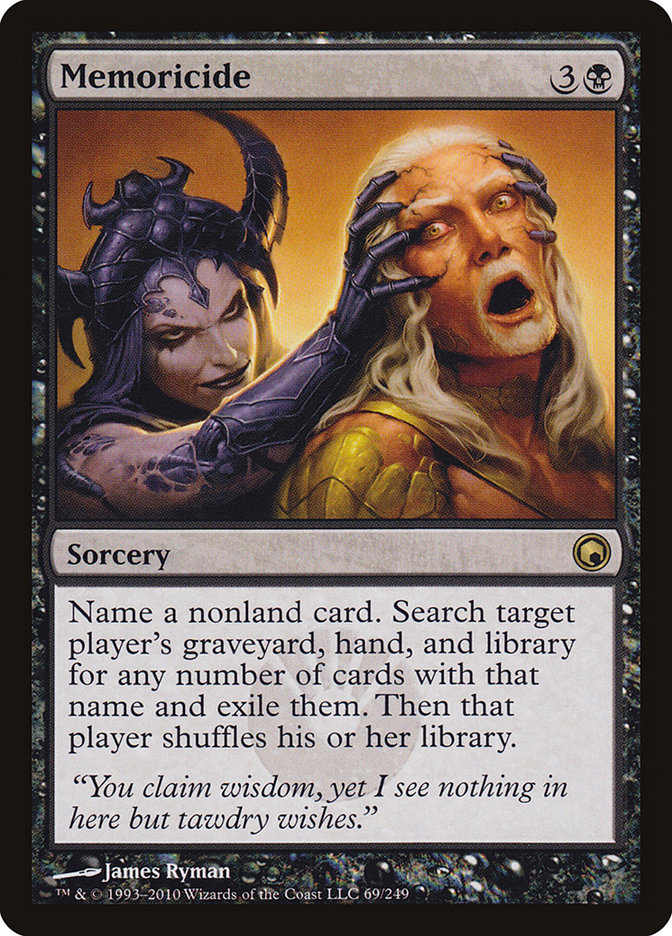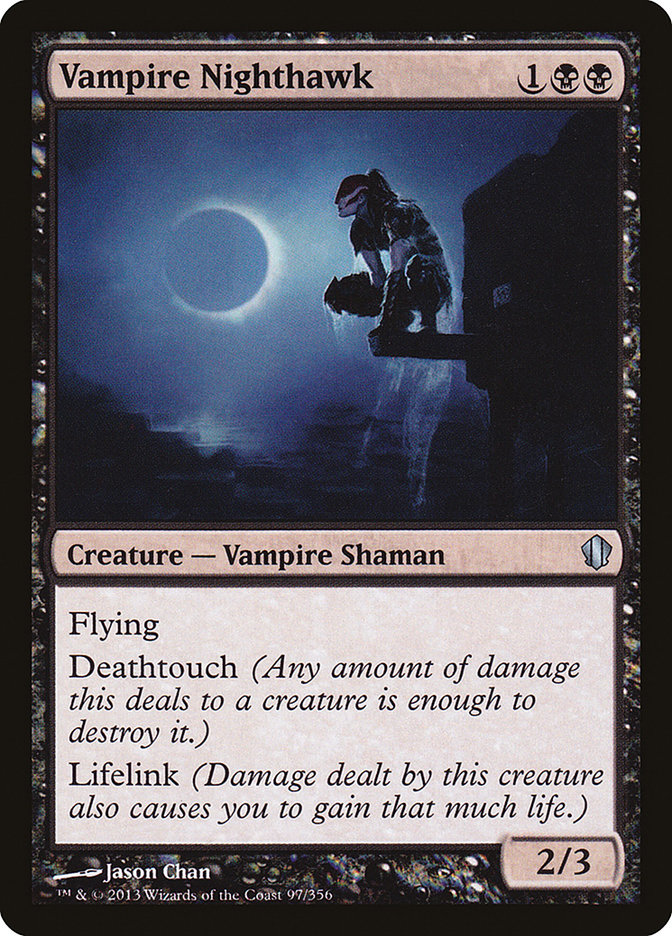Good ol’ Rock. Nothing beats Rock.
Of course, that isn’t strictly true. If you look at my analysis of the Modern portion of Pro Tour Born of the Gods, you can see that in fact a good many decks did outperform the various B/G/x midrange lists played by any number of players. One of the decks that did incredibly well though was straight B/G using one of my favorite cards: Phyrexian Obliterator.
It is pretty hard to make use of this card. BBBB is nothing to sneeze at, and it can preclude a ton of cards from seeing play in your deck, perhaps most notably Tectonic Edge. About two years ago at Grand Prix Chicago, I ran an Obliterator Rock list that included a number of other wild cards (Hypnotic Specter probably most notably), but one of the things that made Specter work was the now departed Deathrite Shaman. Before Pro Tour Born of the Gods, I actually dismissed my old Obliterator Rock deck as a worthwhile deck to consider.
However, Reid Duke didn’t give up on the idea despite this huge loss. Here is his deck:
Creatures (18)
Planeswalkers (4)
Lands (24)
Spells (14)

There is a lot that I like about this list and a little bit I actively dislike. I’ve been playing Obliterator Rock for about two-and-a-half years now, and there are just a few cards I wouldn’t touch, particularly with the loss of Deathrite Shaman.
In the Elves deck I gave Sam Black that he piloted to a spot on the US National Team, one of the cards that really pushed things over the top in the mirror match was Slaughter Pact. When I saw the card in Reid Duke’s list, I felt a little dumbfounded. It’s definitely a card I should have thought of, but I’d completely forgotten about it. Just seeing it in Reid’s list made me all the more willing to imagine that the deck is worth exploring (though Obliterator got me there right from the get-go to be honest).
One of the big cards I don’t like in the list however is Kitchen Finks. I actually don’t know who it is particularly good against, falling to Anger of the Gods, barely registering as a speed bump against Zoo, and being quite slow against anything combo. Similarly, another three-drop I don’t much care for right now is Liliana of the Veil. Lili is an amazing card when she is backed up by Deathrite Shaman and Dark Confidant, but without Deathrite the inclusion of her sometimes feels to me like the security blanket we haven’t quite outgrown yet.
But both Kitchen Finks and Liliana of the Veil do have a point in the deck. Finks is ostensibly hoping to blunt an aggro deck’s attack, and Liliana does a little bit of that work combined with being able to (slowly) disrupt other decks. But disruption is not the only thing you can do to fight other decks. Card advantage is another.
Of Course
Enter Courser of Kruphix. This card has already made a huge splash in Standard, so I decided to give it a try in my updated version of Obliterator Rock. Needless to say, I found the card quite amazing.
Particularly in a deck with so many fetch lands, the card selection is great. Even without Dark Confidant out, you can still end up getting access to so many more cards all while building up your life. Especially since Scavenging Ooze is also in the deck, your ability to shore up your life total is actually pretty great. But importantly, even though Courser of Kruphix only "draws" you lands, just pushing that much deeper into your deck ends up helping you uncover all of the extra disruption and interaction you might want. It isn’t quite Dark Confidant level in this ability, but it is surprisingly good at helping out.
Initially I tried out four copies of Courser of Kruphix in the deck, and it seemed like they were doing quite a bit for me. The more games I played, though, the more I started seeing how lackluster the extra copies were except in the most aggressive matchups. The big problem is that redundant Courser of Kruphix are basically only an insurance policy unless you’re looking for the Spitting Slug body or the minor life gain.
Down to three it went.
I ended up down to one Liliana of the Veil, Willy Edel style. This actually made me a laugh a little, largely because he has also started using Courser of Kruphix. I began looking for other bits of inspiration that might be in his Jund list and found some other interesting choices.
One of them was his choice to only use three copies of Scavenging Ooze; I was contemplating dropping it down myself because of the redundancy problem I kept on having where my Scavenging Ooze all just felt too weak at times against some opponents. However, dropping down didn’t pan out. In the end in the way that my deck was built, I just wanted the extra Ooze. While a part of me started contemplating Funeral Charm again as a card to start carving into the deck with, my list resolved itself into something slightly more conservative than that.
Here is my current version of Obliterator Rock, which I’ve been playing on Magic Online and winning with quite a bit since I put it together:
Creatures (19)
Planeswalkers (2)
Lands (24)
Spells (15)

Before we continue, let’s briefly discuss all of the singletons in the maindeck. With the exception of Sword of Light and Shadow, the single copies of cards in the deck are all removal spells. In many ways these cards are all working with the idea of analog spells. For example, Victim of Night is quite close to a mono-black version of Terminate but in this deck serves as a semi-redundant card to Abrupt Decay, Dismember, Putrefy, and Slaughter Pact. It isn’t quite any of them, but it helps serve the same role as those cards with a different cost (can be cast on turn 2, kills black creatures, kills land creatures, never has an associated life loss).
Each of the removal spells really does have an additional cost of sorts, so spreading them around—as long as they don’t lack real utility and aren’t being outclassed—is a good way to ensure that you don’t overload yourself. Abrupt Decay seems like almost the best possible card to choose at first glance, but after any degree of testing, you’re going to find yourself aggravated that you can’t kill a Birthing Pod, an Inkmoth Nexus, or any other number of cards. Putrefy serves as the halfway point between Abrupt Decay and Maelstrom Pulse, able to kill nearly everything you care about but still a bit expensive.
The single Sword of Light and Shadow serves as an anti Path to Exile card for the deck but also a long game attrition card. Phyrexian Obliterator can dominant any game that it is in, but it is very easily dispatched by a Path. While discard can knock these cards out of the hand before the Obliterator appears, after the fact a topdecked Path isn’t something the deck can actually answer without a card like the Sword. Aside from this, though, the combination of life gain and card advantage can be incredibly valuable against any deck that isn’t comboing you or isn’t simply so fast as to be practically immune to Sword.
The sideboard has a lot of cards that you’ve probably seen in other lists, but I’ll comment on some that might seem unusual.
Darkblast is a very powerful card against Infect and Affinity, is solid against Birthing Pod, and can be brought in against the oddball Elf/Bird-heavy deck. Many decks actually struggle to defeat Darkblast if the card gets any sort of help.
Seal of Primordium can sometimes be the equivalent of a sorcery speed Naturalize, but more often than that it sits in play for a while, forcing the opponent to not make the plays they want. Meanwhile you are working them over with the rest of your disruption. This isn’t a card you usually bring in against opposing Tarmogoyf decks (though you would against RUG Twin), so it only rarely pumps up an enemy Goyf while helping be a part of growing your own Goyf. Much like Victim of Night, this card can be redundant to Abrupt Decay, albeit far more narrow. It is only this narrowness that has me down to one copy.
A great weapon against any of the decks you face that aren’t going to kill you quickly with damage, Phyrexian Arena is your fifth Bob. While Dark Confidant is more fragile, it also has the added benefit of being able to actually attack and block. This sideboard card is currently in my deck because of the sheer number of U/W-based decks out there.
This remains actually one of the cards I’m less certain on, mostly because in all of the matches I’ve played with the deck on Magic Online I still haven’t drawn it. In the previous version of Obliterator Rock, this effect was devastating against combo decks, but that was when Deathrite Shaman was still around. While theoretically it might be exactly what the deck needs, in practice it might be too slow. Unfortunately I don’t yet know; consider this card only cautiously endorsed.
Vampire Nighthawk is a strange card. For Modern it’s a pretty expensive proposition in a world full of Lightning Bolt and Lightning Helix. At the same time your deck is one where there are a great deal of other targets. The reason that Vampire Nighthawk is in the deck is as a two-fer response to Affinity and Zoo at the same time while being marginally good against a number of other decks (Infect being the biggest one, but even Scapeshift can find the card frustrating). If Vampire Nighthawk were the only (or one of the only) creatures in the deck, it simply wouldn’t do nearly enough to make it a worthwhile card, but since you can usually count on Nighthawk to have had other friends die before it gets to the table, it can end up actually mimicking the havoc it produced in Sealed.
This card is always a solid one to put in versus nearly any opponent if you have cards you want to take out but don’t really have anything specific you want to bring in to fill the space; it will be mediocre in those cases, but a mediocre card is better than a bad card. In the Affinity matchup when backed up by other powerful cards, Vampire Nighthawk really shines.
The other cards in the deck aren’t anything new. More discard, more anti-strategy cards (Grafdigger’s Cage, Creeping Corrosion), more removal. I’ve stopped using Fulminator Mage, largely because the card can be generally useful but was most effective versus G/R Tron. Without a large presence of G/R Tron, I just don’t think Fulminator Mage does enough to warrant inclusion, even though it is also useful against Scapeshift and odd cases like Amulet Combo. If you have a lot of those decks in your metagame, consider carving out room for four; if they’re good, then they’re good, so get to it.
I’m not going to attend Richmond, but if I were, this would absolutely be one of the decks I’d be considering (the others being Burn, U/W Midrange Control, and BluManji in order). At an event last year, I very nearly played it during the Modern portion (albeit with Deathrite Shaman), and it is just an impressively powerful deck.
A part of what I love about this deck is that it has game against absolutely everyone. It’s exciting to see Phyrexian Obliterator finally getting the love it deserves, and if you’ve never played an Obliterator, it is shocking just how much impact that even one has once it is on the board. Getting into a fight with an Obliterator always feels like a losing proposition, and with five power of trample, you can’t really ignore the card for more than a turn or two before the end is nigh.
If you’re looking for a powerful midrange deck for Grand Prix Richmond, I heartily recommend my version of Obliterator Rock. If you use it, make sure you pack a few Harmonize, Dismember, and Victim of Night with you just in case the room fills up with Black-Black-Black-Black.


